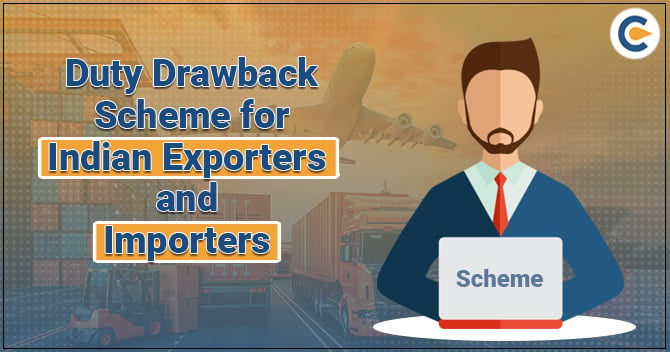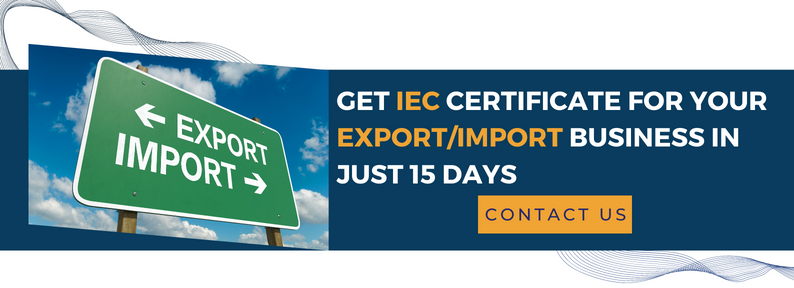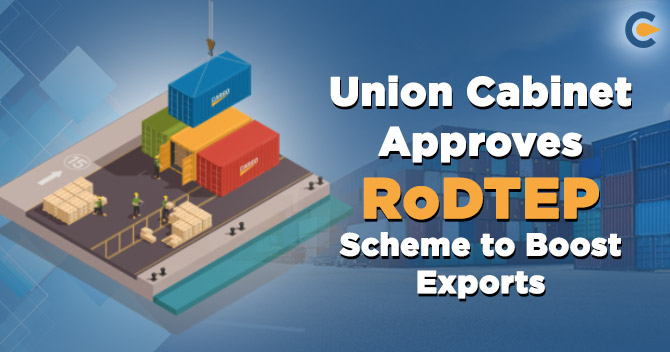Duty Drawback Scheme (DBK) is a government-based initiative that allows the exporter to avail rebate on the input used in the production of exportable goods. The admissible duty drawback is forwarded to exporters in their registered bank account. Section 75 of the Customs Act, 1962 & Section 37 of the Central Excise Act, 1944, enable the government to render such duty drawbacks.
Role of Customs & Central Excise Duties Drawback Rules
- Customs & Central Excise Duties Drawback Rules, 1995 encloses the procedure for granting of duty drawback (for both kinds of duties imposed) by the central authorities processing documents of export. Under the said scheme, an exporter can choose either the brand rate of Duty Drawback Scheme or All Industry Rate (AIR) of Duty Drawback Scheme.
- A major percentage of duty drawback is paid via AIR DBK which primarily renders compensation to exporters of various exportable goods for the average incidence of central excise and customs duties imposed on the input used in their production.
- Brand rate of duty drawback is conferred under rules & 7 of Customs and Central Excise Duties Drawback Rules, 1995 in events where the exportable goods do not have any AIR or duty drawback rate, or where the AIR duty drawback prompted is considered by the exporter inadequate to compensate for Customs/Central Excise duties on imported goods used in the production of exportable products.
- For commodities having an AIR, the facility of brand rate to exporters is only accessible if it is determined that the compensation by AIR is lower than 80 percent of the actual duties addressed in the production of the exportable goods.
- Duty drawback on re-export of duty paid commodities is also accessible under Section 74 of Customs Act, 1962. Under this scheme, a certain part of customs duty addressed at the time of importation is remitted on re-export of the commodities subject to identification & standard procedure being followed.
Categories of Duty drawback
There are ranges of categories of Duty drawback, but the two widely-known categories are; Manufacturing and unused merchandise
Manufacturing duty drawback comes into play when you import a product that is then used in the production of different goods.
For instance, if you import bike tires and export finished motorcycles, then you can get the duty you paid for the bike tire refunded when you ship the finished bike. On the other hand, unused merchandise duty drawback comes into play when you import something, and then export it in unused condition.
If you import bike tires and then export the same without any value addition, then you can avail of the refund for the duty paid when you export the tires.
How does the Duty Drawback scheme work for exporters?
- AIRs are notified by the central government in the form of a drawback schedule depending on the average quantity & valuation of inputs and duties (both central excise and customs) encountered by the export products. The rates are primarily an average depending on the evaluation of average incidence. These AIRs are underpinned by the drawback committee.
- The AIR might be fixed as a % of FOB i.e. Free onboard price of exportable products or as standard rates. FOB is used to imply whether the buyer or seller is accountable for goods that are physically damaged during transit. All claims relating to duty drawbacks are filed in accordance with the tariff items and descriptions of products given in the schedule.
- In the Brand Rate fixation, an exporter can apply either where the exportable item has not been cited in the duty drawback schedule or if the exporter considers that AIR of duty drawback does not completely waived-off the duties encountered by his export product.
- The exporter is fully compensated for duties relating to customs and central excise actually incurred by them. To use such a route, the exporter must furnish a form to the Directorate of Drawback within thirty days of the first transit of goods, along with a copy of the relevant authorities.
- The commissioner-drawback shall fix the rate post verification. The documentation requisite is high here, as the exporter has to disclose the quantity of inputs and serviced used, in addition to the proof of duties paid.
How to Avail Refunds under the Scheme?
In order to avail refunds under the scheme, the exporter must file a DBK application with relevant custom authority via electronic data interchange (aka EDI) for the export. Here, the exporter must remember that the e-shipping bills will serve as a claim for drawback, and thus there is no requirement of filing separate drawback claims.
All custom ports equipped with EDI facility can process claims related to Duty drawback scheme in case of re-export of imported goods u/s 74 of the Customs Act, 1962.
Citing invalid bank information or not updating account details can extend processing time for the Duty drawback scheme application. Likewise, entering the invalid serial no. of the drawback claim in the shipping bill will also contribute to processing delay. Thus, it is advisable to identify an error in the first place before rushing for application submission.
Documents Required for Processing Drawback Claim
- Triplicate copy of the Shipping Bill
- Copy of the Bill of entry
- Invoice of the Import
- Proof related to the payment of duty paid on the goods being imported
- Approval granted by RBI[1] for re-exportation of goods
- Copy of the Airway bill and bill of lading
- Copy of bank attested invoices.
- Sixtuplicate Copy of AR-4
- Packing list as well as export invoice
- Freight & Insurance certificate
- Copy of report pertaining to goods’ testing
- Modvat Declaration
- A proof reflecting the drawback amount claimed
- DEEC Book and license copy where applicable.
- Certificate of transshipment where applicable
- Blank acknowledgment card in duplicate
- Pre-receipt relating to drawback amount on the reverse of shipment bill signed on the Rs1/- revenue stamp
Limitations on Drawback Admissibility
The Customs Act underpins certain conditions and limitations for exporters seeking a drawback-related claim for inputs. No drawback is admissible u/s 75 if the market price is lower than the drawback’s amount claimed.
The drawback is also not allowed if the claim is lower than Rs 50 on individual transits. GOI can reject or admit drawback claims subject to conditions where there is a chance of goods shipped being smuggled back.
Further, the government can also deny drawback claims in a situation where the export of goods is less than the valuation of input used in their production. If necessary, standard minimum value addition over the valuation of input can also be prescribed prior to rendering drawback. Please note that the drawback is allowed to incentivize exports and there must be export proceeds repatriation.
Although prior repatriation of export realization isn’t a mandate, the law states that if sale proceeds are not received within the given timeline, the drawback paid shall be recoverable by the GOI as per the underlying procedure.
Important statutory provisions and rules pertaining to drawback
I. STATUTORY PROVISIONS
| S.NO | Section Nos | Subject |
| 1 | Section 74 of Customs Act, 1962 | Drawback on re-export of imported duty paid goods |
| 2. | Section 75 of Customs Act, 1962 | Drawback on input materials/services used for manufacture of export goods. |
II. DRAWBACK RULES, 1995
| S.NO. | Rule Nos | Subject |
| 1 | Rule 5 | Determination of date from which the amount of drawback is to come to effect and the date of application of amount of drawback. |
| 2 | Rule 8A | Upper Limit of Drawback money or rate |
| 3 | Rule 13 | Procedure & timeline for claiming drawback on exportable goods other than by post |
| 4 | Rule 15 | Supplementary claim |
| 5 | Rule 16 | Repayment of invalid or extra payment of drawback and interest. |
| 6 | Rule 16A | Recovery of amount of Drawback in case of non-realization of export proceeds |
Conclusion
A duty drawback scheme refers to a rebate of any duty paid on imported materials that importers used to process or produce exportable products. It can be claimed by filing a prescribed application with relevant custom authority along with standard documents such as shipping bills.
Read our Article:How the IEC for Startup could be Beneficial in India?













